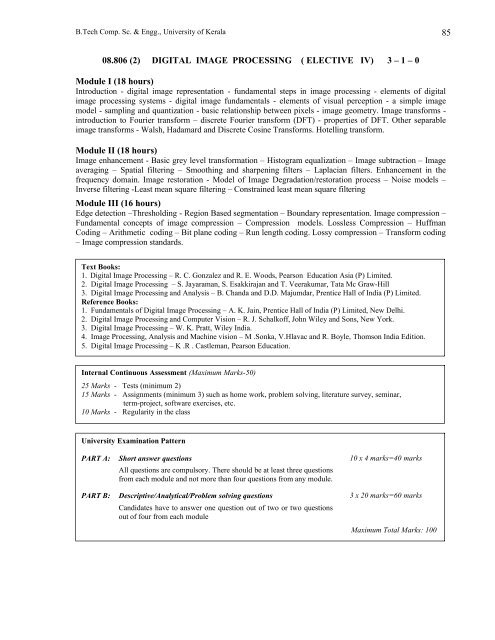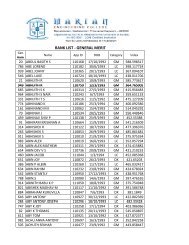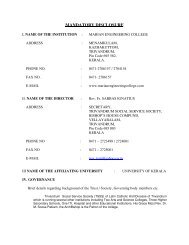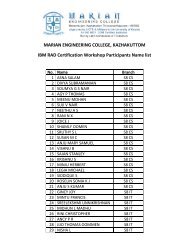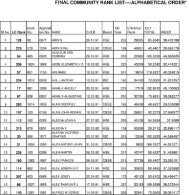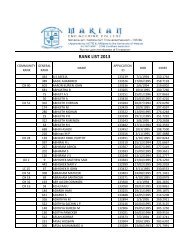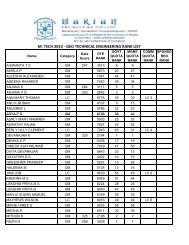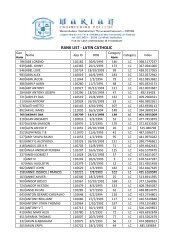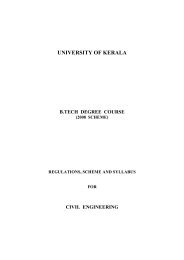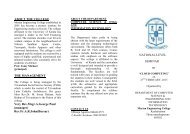UNIVERSITY OF KERALA - Marian Engineering College
UNIVERSITY OF KERALA - Marian Engineering College
UNIVERSITY OF KERALA - Marian Engineering College
You also want an ePaper? Increase the reach of your titles
YUMPU automatically turns print PDFs into web optimized ePapers that Google loves.
B.Tech Comp. Sc. & Engg., University of Kerala 85<br />
08.806 (2) DIGITAL IMAGE PROCESSING ( ELECTIVE IV) 3 – 1 – 0<br />
Module I (18 hours)<br />
Introduction - digital image representation - fundamental steps in image processing - elements of digital<br />
image processing systems - digital image fundamentals - elements of visual perception - a simple image<br />
model - sampling and quantization - basic relationship between pixels - image geometry. Image transforms -<br />
introduction to Fourier transform – discrete Fourier transform (DFT) - properties of DFT. Other separable<br />
image transforms - Walsh, Hadamard and Discrete Cosine Transforms. Hotelling transform.<br />
Module II (18 hours)<br />
Image enhancement - Basic grey level transformation – Histogram equalization – Image subtraction – Image<br />
averaging – Spatial filtering – Smoothing and sharpening filters – Laplacian filters. Enhancement in the<br />
frequency domain. Image restoration - Model of Image Degradation/restoration process – Noise models –<br />
Inverse filtering -Least mean square filtering – Constrained least mean square filtering<br />
Module III (16 hours)<br />
Edge detection –Thresholding - Region Based segmentation – Boundary representation. Image compression –<br />
Fundamental concepts of image compression – Compression models. Lossless Compression – Huffman<br />
Coding – Arithmetic coding – Bit plane coding – Run length coding. Lossy compression – Transform coding<br />
– Image compression standards.<br />
Text Books:<br />
1. Digital Image Processing – R. C. Gonzalez and R. E. Woods, Pearson Education Asia (P) Limited.<br />
2. Digital Image Processing – S. Jayaraman, S. Esakkirajan and T. Veerakumar, Tata Mc Graw-Hill<br />
3. Digital Image Processing and Analysis – B. Chanda and D.D. Majumdar, Prentice Hall of India (P) Limited.<br />
Reference Books:<br />
1. Fundamentals of Digital Image Processing – A. K. Jain, Prentice Hall of India (P) Limited, New Delhi.<br />
2. Digital Image Processing and Computer Vision – R. J. Schalkoff, John Wiley and Sons, New York.<br />
3. Digital Image Processing – W. K. Pratt, Wiley India.<br />
4. Image Processing, Analysis and Machine vision – M .Sonka, V.Hlavac and R. Boyle, Thomson India Edition.<br />
5. Digital Image Processing – K .R . Castleman, Pearson Education.<br />
Internal Continuous Assessment (Maximum Marks-50)<br />
25 Marks - Tests (minimum 2)<br />
15 Marks - Assignments (minimum 3) such as home work, problem solving, literature survey, seminar,<br />
term-project, software exercises, etc.<br />
10 Marks - Regularity in the class<br />
University Examination Pattern<br />
PART A: Short answer questions 10 x 4 marks=40 marks<br />
All questions are compulsory. There should be at least three questions<br />
from each module and not more than four questions from any module.<br />
PART B: Descriptive/Analytical/Problem solving questions 3 x 20 marks=60 marks<br />
Candidates have to answer one question out of two or two questions<br />
out of four from each module<br />
Maximum Total Marks: 100


